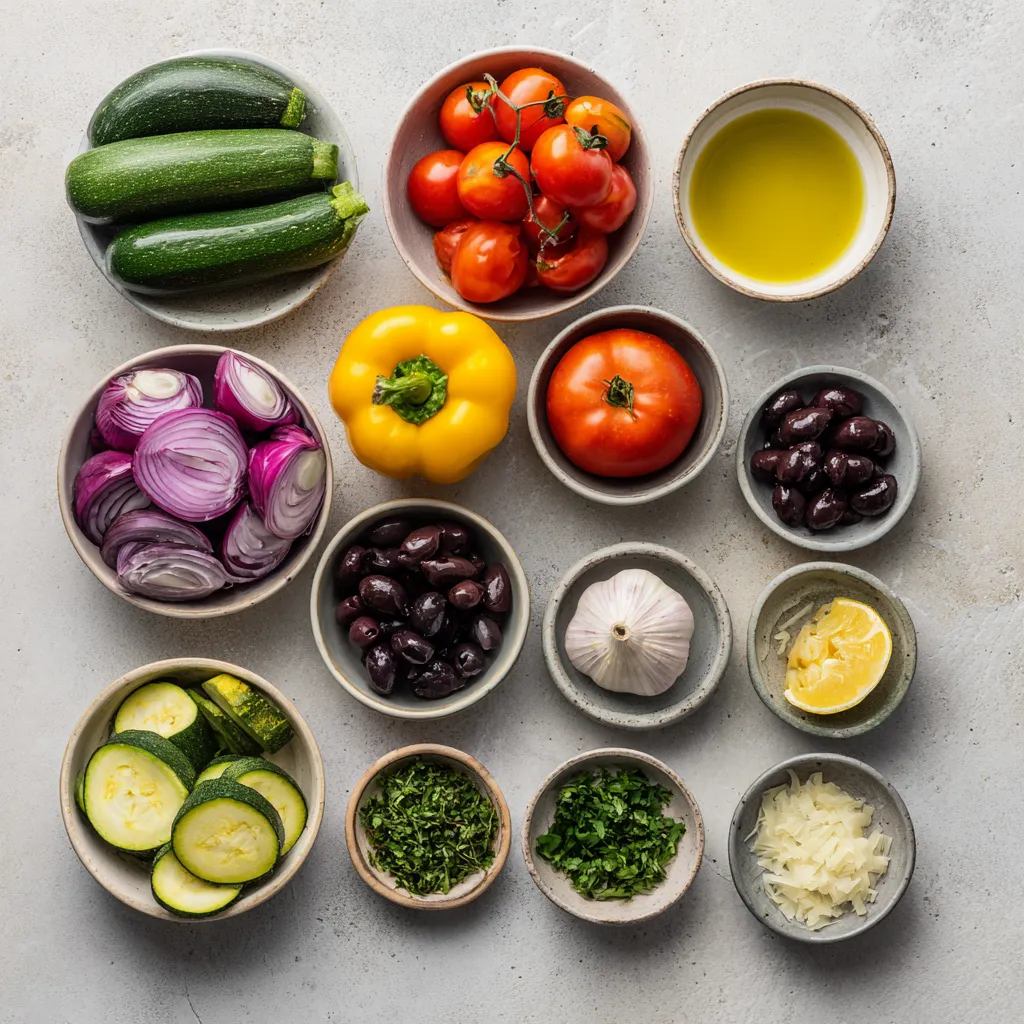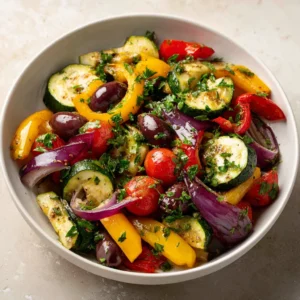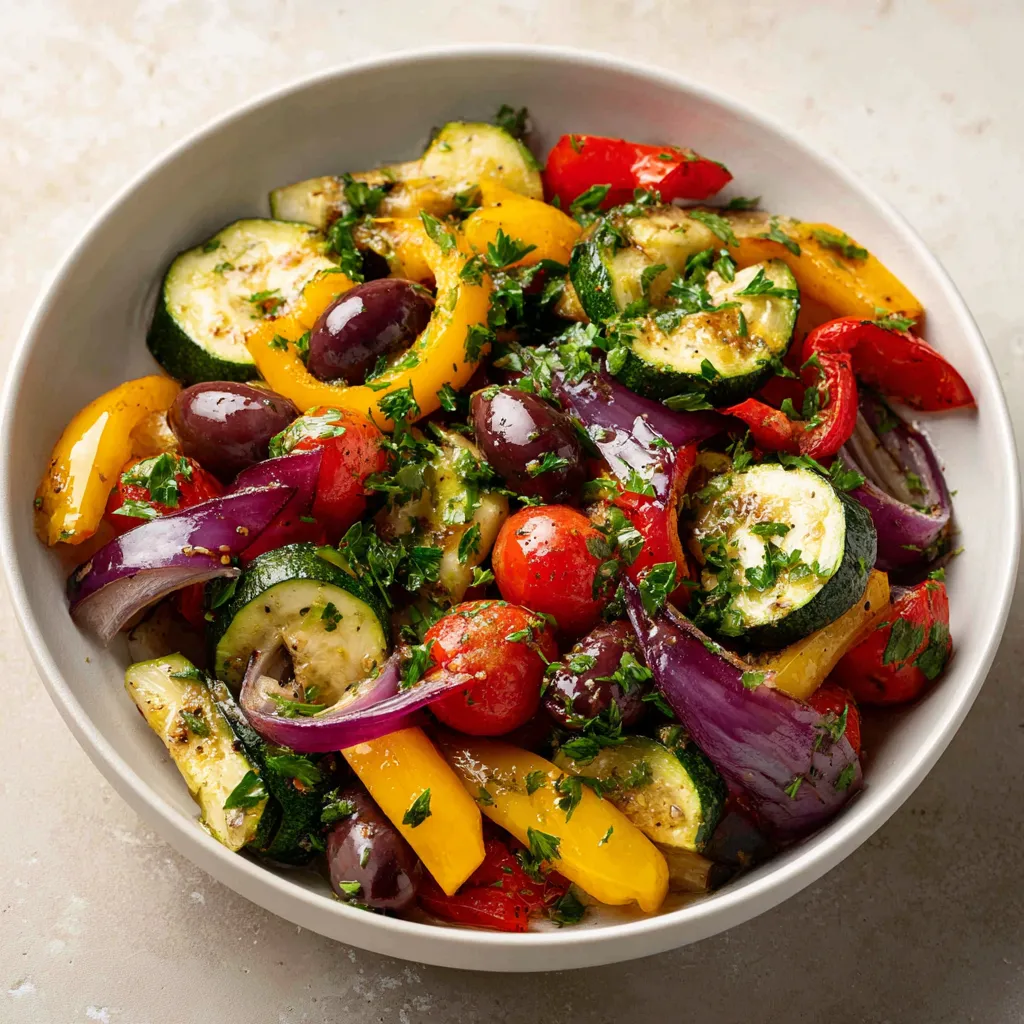Introduction
Mediterranean cuisine is renowned for its vibrant flavors, wholesome ingredients, and health benefits. The Slow-Cooked Mediterranean Garden Delight exemplifies these qualities beautifully, offering a dish packed with colorful vegetables that both pleases the palate and nourishes the body. This dish showcases an assortment of fresh ingredients, each contributing to the overall depth of flavor while celebrated for their nutritional value.
The art of slow cooking vegetables allows for a gentle melding of flavors that can’t be achieved through quick cooking methods. As the ingredients simmer together in the slow cooker, each vegetable releases its natural juices, resulting in a harmonious blend that is aromatic and satisfying. Whether served as a colorful side dish or as a hearty main course over grains, this recipe captures the essence of sunny Mediterranean gardens.
In addition to its delightful taste, this dish also boasts an array of health benefits. Ingredients like zucchini, eggplant, and bell peppers are not only rich in vitamins and minerals but also low in calories, making them perfect for anyone looking to maintain a balanced diet. The inclusion of olives adds healthy fats and antioxidants, further enhancing the dish’s nutritional profile.
Recipe Overview
– Total Time: 4-6 hours on low or 2-3 hours on high
– Yield: Not specified in the recipe
– Difficulty: Not specified in the recipe
Ingredients
– 2 cups zucchini, sliced into half-moons
– 1 cup assorted bell peppers (red, yellow, green), chopped into bite-sized pieces
– 1 cup cherry tomatoes, cut in half
– 1 medium red onion, chopped finely
– 1 cup eggplant, diced into cubes
– 1/2 cup Kalamata olives, pitted and halved
– 4 cloves garlic, minced
– 1 teaspoon dried oregano
– 1 teaspoon dried basil
– 1/2 teaspoon red pepper flakes (optional for heat)
– Salt and freshly ground black pepper to taste
– 1/4 cup extra-virgin olive oil
– Juice of 1 fresh lemon
– Fresh parsley, chopped (for garnish)

Instructions
1. Prepare the Vegetables: Wash all vegetables thoroughly. Slice the zucchini and chop the bell peppers and red onion into equal-sized pieces. Cube the eggplant and soak it in salted water for about 10 minutes to remove any bitterness, then drain, rinse, and pat dry with a clean towel.
2. Mix the Seasoning: In a medium bowl, combine the minced garlic, olive oil, lemon juice, dried oregano, dried basil, red pepper flakes, and a pinch of salt and pepper. Whisk this mixture together until it is evenly blended.
3. Layer in the Crockpot: Start layering your vegetables in the slow cooker. Begin with the sliced zucchini and cubed eggplant at the bottom, followed by the chopped bell peppers, diced red onion, and halved cherry tomatoes, creating a colorful gradient.
4. Add Olives and Seasoning: Once the vegetables are layered, sprinkle the halved Kalamata olives evenly over the top. Drizzle the prepared seasoning mixture over the vegetables, ensuring everything is coated well.
5. Cook: Put the lid on the crockpot and set it to cook on low for 4 to 6 hours, or on high for 2 to 3 hours. The vegetables should become tender but maintain some texture.
6. Serve: After cooking, gently stir the vegetable medley to combine the flavors. Taste and adjust seasonings if needed. Serve hot, garnished with a sprinkle of fresh parsley.
7. Enjoy: Relish this dish as a flavorful side, or elevate the meal by serving it over fluffy quinoa or couscous for a delicious and hearty main course!
Preparing the Vegetables
Proper preparation of the vegetables is essential for achieving the best flavor and texture in your Slow-Cooked Mediterranean Garden Delight. Begin by washing all the vegetables thoroughly under cold running water to remove any dirt or residues. The cleanliness of the produce not only influences the dish’s taste but also reflects on the overall safety of the meal.
Zucchini should be sliced into half-moons with a sharp knife, preferably maintaining uniform thickness for even cooking. Bell peppers, regardless of color, should be chopped into bite-sized pieces, making them convenient to eat and ensuring they cook down properly. The red onion is then finely chopped, which will help its flavor infuse throughout the dish without overwhelming any single element.
The eggplant, known for its slightly bitter taste, necessitates special attention. Dicing it into cubes and soaking it in salted water for approximately 10 minutes helps mellow its bitterness, allowing for a more pleasant flavor profile once cooked. After soaking, it’s essential to drain, rinse, and pat dry the eggplant before adding it to the other vegetables; this prevents excess moisture from diluting the dish itself.
Crafting the Seasoning
Fresh herbs and spices are the backbone of this Mediterranean recipe, greatly enhancing the flavor profile without the need for heavy sauces or additives. In a medium bowl, the minced garlic is the first element to combine, as it provides a robust aromatic foundation for the dish. Next, adding extra-virgin olive oil creates a luscious base that helps carry the flavors of the herbs while also promoting a tender texture in the vegetables.
The juice of a fresh lemon adds acidity, which is particularly vital in balancing the natural sweetness of the cherry tomatoes and the richness of the olives. Dried oregano and basil both contribute warm, earthy tones characteristic of Mediterranean cuisine. If you enjoy a hint of heat, incorporating red pepper flakes can add that spicy kick; however, keep in mind this is optional.
After adding a pinch of salt and freshly ground black pepper to the mixture, whisking until everything is well blended is crucial. This ensures that the flavors become harmonious, and every bite of the vegetables will carry the same enticing essence.
Layering in the Crockpot
The layering process plays an integral role in how the Slow-Cooked Mediterranean Garden Delight cooks. By starting with zucchini and eggplant at the base of the slow cooker, you allow these denser vegetables to absorb the flavors of the seasonings and juices from the other, lighter ingredients as they cook.
Follow this with the vibrant bell peppers and finely diced red onion, which add sweetness to the mixture. As you layer, be mindful to maintain an even distribution of vegetables. Over time, the cherry tomatoes, known for their juicy bursts of flavor, should be placed on the top layer. This not only prevents them from overcooking but also enhances the dish’s visual appeal with their bright color.
The goal is to create a colorful gradient that makes the dish as beautiful as it is delicious. Each layer contributes to the final flavor and texture of the dish, allowing for a slow melding of tastes that is nothing short of spectacular once complete.
Incorporating Olives and Seasoning
Kalamata olives are a hallmark of Mediterranean cooking, celebrated not only for their rich flavor but also for the healthy fats they provide. When selecting olives, look for pitted varieties to save time in preparation. Splitting them in half ensures their flavor infuses throughout the vegetable medley, contributing brininess that complements the sweetness of the cooked vegetables.
Sprinkling the halved Kalamata olives evenly over the top of the layered vegetables ensures that every scoop of the dish comes with that delightful Mediterranean essence. The drizzling of the mixed seasoning over the entire assembly promotes even coating of the vegetables, ensuring that they soak up the aromatic garlic, zesty lemon, and fragrant herbs.
This step is essential for unifying the flavors, allowing the dish to develop its distinct character during the cooking process. Making sure that all components are well-distributed sets the stage for a slower cooking phase, where the melding of these elements transforms simple vegetables into a communal Mediterranean feast that is both heartwarming and unforgettable.
{{image_3}}
Ensuring an Even Coat of Seasoning Over the Vegetable Medley
A crucial step in achieving the perfect flavor balance in your Slow-Cooked Mediterranean Garden Delight is ensuring that every piece of vegetable is evenly coated with the seasoning mixture. This involves drizzling the olive oil and herb combination throughout the different layers. Mixing with your hands can be an effective method; gently toss the vegetables with the seasoning before placing them into the crockpot to ensure every bite is bursting with flavor. Additionally, when it’s time to stir the dish after cooking, aim for a gentle folding motion to avoid mashing the vegetables, maintaining their integrity while integrating the seasonings well.
Cooking Techniques
Slow Cooking vs. Quick Cooking Methods
This recipe capitalizes on the virtues of slow cooking, allowing the vegetables to release their natural flavors gradually while retaining moisture and nutrients. Slow cooking offers the advantage of developing deeper and more cohesive flavors, something that’s hard to achieve with high-heat methods like roasting or sautéing. While quick cooking could yield firmer-textured vegetables, it typically wouldn’t allow the taste to meld as beautifully.
Ideal Timing for Each Temperature Setting
The recommended cooking times for the Slow Cooker vary depending on the heat setting. For a low setting, you should aim for 4 to 6 hours, while the high setting works well within 2 to 3 hours. These time frames are guidelines; you might need to adjust based on your slow cooker brand and model as some cook hotter or cooler than others.
How to Tell When the Vegetables Are Perfectly Cooked
The key to determining if your vegetables are properly cooked lies in their texture. They should be tender enough to easily pierce with a fork but still have a slight bite, also known as “al dente.” If the vegetables fall apart, they may have overcooked—still delicious but diversely textural. It’s also important to periodically check for bubbling in the sauce, which indicates active simmering and proper heat distribution.
Serving Suggestions
Various Ways to Serve the Dish as a Side
This Mediterranean dish can serve as a stand-alone side accompanying myriad main courses. Consider pairing it with grilled proteins like chicken, shrimp, or fish for a balanced meal. It can complement heavier dishes such as beef stews or roasted leg of lamb due to its bright flavors cutting through richness.
Transforming the Dish Into a Main Course with Grains
To make the Slow-Cooked Mediterranean Garden Delight an even heartier main course, serve it over a bed of grains like quinoa, couscous, or bulgur. The flavors of the dish harmonize well with the nuttiness of these grains, providing a fulfilling meal whilst adding texture and substance.
Suggestions for Complementary Wines or Beverages
Wine enthusiasts may enjoy pairing this garden delight with a crisp white wine like a Sauvignon Blanc or a light-bodied red such as a Pinot Noir. These options will enhance the fresh flavors of the dish, allowing the citrusy notes to shine through. Non-alcoholic beverages such as sparkling water with a hint of lemon or herbal iced teas can also complement the medley without overpowering its flavors.
Optional Presentation Tips
Visual Appeal in Food Serving
Enhancing presentation elevates the dining experience; the colorful array of vegetables in this dish naturally attract the eye. Serving the dish in a large, shallow bowl allows the vibrant colors of the zucchini, bell peppers, and cherry tomatoes to take center stage.
How to Enhance Presentation with Garnishes
Fresh parsley is an excellent garnish, adding a vibrant green contrast and a pop of freshness. Other options include finely grated lemon zest for additional brightness, or a light drizzle of balsamic reduction for a touch of sophistication.
Ideas for Serving Vessels That Elevate the Dining Experience
Consider using rustic ceramic bowls or wooden platters for a Mediterranean aesthetic. These choices can add warmth and charm, making the dish feel like an experience rather than just a meal.
Health Benefits of Ingredients
Nutritional Breakdown of the Featured Vegetables
This dish comprises a wealth of nutrients thanks to its vegetable medley. Zucchini is hydrating and low in calories, providing vitamins A and C. Bell peppers are rich in vitamin C and antioxidants, while eggplant contributes fiber and minerals like potassium. Cherry tomatoes are packed with lycopene, promoting heart health, and olives add healthy fats to the mix.
Antioxidant Properties of Olive Oil and Herbs
Extra-virgin olive oil is a hallmark of Mediterranean diets, known for its monounsaturated fats and antioxidants. The use of dried oregano and basil not only enhances the dish’s flavor but also provides anti-inflammatory properties and further enriches the antioxidant profile.
Benefits of Including Olives in Your Diet
Kalamata olives are not only delicious but also provide healthy fats and antioxidants. They are linked to various health benefits, including improved heart health and reduced inflammation.
Storing and Reheating
Best Practices for Storing Leftovers
To preserve flavor and freshness, store leftovers in an airtight container in the refrigerator. It’s best to allow the dish to cool to room temperature prior to sealing it, which prevents moisture buildup that can lead to spoilage.
Tips on Reheating to Retain Flavor and Texture
When reheating, do so gently. Use the stovetop or microwave, adding a splash of water to reactivate the steam. This will help keep the vegetables from drying out. Gently stir the vegetables while heating, ensuring even warmth.
Guidelines for Freezing the Dish for Future Use
If you wish to freeze the Slow-Cooked Mediterranean Garden Delight, portion out the cooled dish in freezer-safe bags or containers, allowing for little air as possible to reduce freezer burn. It’s best to consume the frozen portions within 2-3 months.
Variations and Customizations
Ideas for Substituting Vegetables Based on Availability
Flexible in its nature, this recipe allows for plenty of vegetable substitutions. Consider using seasonal vegetables such as asparagus, yellow squash, or even root vegetables like carrots and sweet potatoes depending on your preference and availability.
Optional Proteins to Add for a Heartier Dish
For a more filling option, consider adding chickpeas or cannellini beans to the vegetable mix, enhancing the protein content. Alternatively, diced cooked chicken or sautéed shrimp can be mixed in during the final hour of cooking to meld flavors without overcooking the meats.
Techniques for Altering Spice Levels to Suit Preferences
Adjust the spice level by omitting the red pepper flakes or adding more, depending on your taste preferences. Alternatively, incorporating fresh herbs or a splash of hot sauce right before serving can provide an instant flavor boost without overwhelming the dish.
Conclusion
The Slow-Cooked Mediterranean Garden Delight is a vibrant medley of flavors and textures that culminate in a satisfying dish perfect for any occasion. With its tender vegetables and aromatic seasoning, this recipe embodies the essence of Mediterranean cooking while being easy to prepare. Enjoy it hot as a side or as a wholesome main course over grains for a delightful meal experience.


